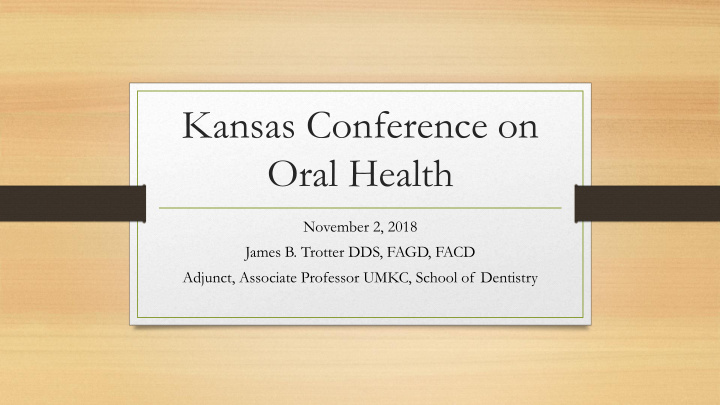



Kansas Conference on Oral Health November 2, 2018 James B. Trotter DDS, FAGD, FACD Adjunct, Associate Professor UMKC, School of Dentistry
• “Every human has four endowments - self awareness, conscience, independent will and creative imagination. These give us the ultimate human freedom... The power to choose, to respond, to change.” Steven Covey
• "The best interest of the patient is the only interest to be considered, and in order that the sick may have the benefit of advancing knowledge, union of forces is necessary.” Dr. William Mayo 1910
Resources • TEETH by Mary Otto • Quick read and overview of how our system of dental practice evolved. • Helps one understand how access to care became a challenge for dental care • Recommend to colleagues who are interested in public and oral health
Resources • Association of State and Territorial Dental Directors • https://www.astdd.org/best-practice-approach-reports/ • https://www.astdd.org/use-of-fluoride-in-schools/ • http://www.astdd.org/school-based-dental-sealant-programs/ • https://www.astdd.org/best-practice-approach-report-oral-health-in-the-older-adult- population
Resources • American Association for Community Dental Programs • https://www.aacdp.com/ Improving access to care through Interprofessional Collaboration Ann Battrell (American Dental Hygienists’ Associa- tion [ADHA]), Marcia Brand (National Interprofessional Initiative on Oral Health), and Patricia Braun (University of Colorado) discussed ways that engaging in interprofessional collaboration can improve access to oral health care.
Resources • Iowa Department of Public Health • https://idph.iowa.gov/ohds/oral-health-center • Public Health Supervision of Hygienists • Public Health Supervision of Dental Assistants • A dental hygienist/assistant may enter into a collaborative agreement with a dentist, allowing the hygienist to provide services to a patient in a public health setting, prior to the patient seeing a dentist for an exam. The Oral Health Center is responsible for collecting the collaborative agreements and annual reports from the dental hygienists working under public health supervision.
Resources • Wisconsin Department of Health Services (Oral Health Program) • https://www.dhs.wisconsin.gov/oral-health/programs/index.htm • http://www.chawisconsin.org/documents/OH3OralHealthRoadmap.pdf
Resources • Ohio Department of Health (Oral Health) • www.odh.ohio.gov/odhprograms/ohs/oralhealth.aspx • Thank you Dr. Bonnie Branson, UMKC School of Dentistry
Practice Guidelines-A New Model • Evidence-based clinical practice guideline on nonrestorative treatments for carious lesions • A report for the American Dental Association
Conclusions and implications • “Although the recommended interventions are often used for caries prevention, or in conjunction with restorative treatment options, these approaches have shown to be effective in arresting or reversing carious lesions . Clinicians are encouraged to prioritize use of these interventions based on effectiveness, safety, and feasibility.”
Significance • Caries in the US • 2015-2016 40% of children affected by caries • 2011-2012 90% of adults affected by caries • 2010 cost of treating caries in US $120 billion • Racial inequality- Hispanic youth highest at 52% • Income inequality- low income groups impacted at higher rate than high-income
The Goal- Caries Management Patient level interventions Diet counseling Oral hygiene instruction Compliance?
The Goal-Caries Management Lesion-level interventions Non-restorative (non-invasive) Nonsurgical (micro-invasive) Restorative/minimally invasive Invasive
Definitions • Non-cavitated carious lesions- surfaces that appear macroscopically intact and without clinical evidence of cavitation. (incipient, initial, early, whitespot) • Cavitated carious lesions- surface not macroscopically intact and with a distinct discontinuity or break in the surface integrity, usually determined using visual or tactile means.
Non-cavitated
Cavitated
Advanced cavitated lesions on any coronal tooth surface • To arrest advanced cavitated carious lesions of primary teeth- prioritize 38% Silver Diamine Fluoride (SDF) solution, biannual application, over 5% NaF varnish (applied once per for week for 3 weeks) Strong recommendation • To arrest advanced cavitated carious lesions of permanent teeth- prioritize use of 38% SDF solution biannually over 5% NaF varnish (applied once per week for 3 weeks) Conditional recommendation
Non-cavitated lesions on occlusal surfaces • To arrest or reverse non-cavitated carious lesions on occlusal surfaces of primary teeth- prioritize use of sealants plus 5% NaF varnish application (every 3-6 months) or sealants alone over 5% NaF, 1.23% APF, or 0.2% NaF mouth rinse. Strong Recommendation • To arrest or reverse non-cavitated carious lesions on occlusal surfaces of permanent teeth- prioritize use of sealants plus 5% NaF varnish application (every 3-6 months) or sealants alone over 5% NaF varnish alone, 1.23% APF gel, or 0.2% NaF mouthrinse. Strong Recommendation
Non-cavitated lesions on approximal surfaces • To arrest or reverse non-cavitated carious lesions on approximal surfaces of primary and permanent teeth- use 5% NaF varnish, applied every 3-6 months, resin infiltration alone, resin infiltration plus 5% NaF varnish or sealants alone. Conditional recommendation
Non-cavitated lesions on facial or lingual surfaces • To arrest or reverse non-cavitated carious lesions on facial or lingual surfaces of primary and permanent teeth- use 1.23% APF gel(application every 3-6 months0 or 5% NaF varnish (applied every 3-6 months). Conditional recommendation
Non-cavitated and cavitated lesion on root surfaces • To arrest or reverse non-cavitated and cavitated carious lesions on root surfaces of permanent teeth- prioritize the use of 5,000 ppm fluoride (1.1% NaF) toothpaste or gel at least once per day) over 5% NaF varnish, 38% SDF plus potassium iodide solution annual application, 38% SDF solution annually, or 1% chlorhexidine plus 1% thymol varnish, every 3-6 months. Conditional recommendation
Recommend
More recommend